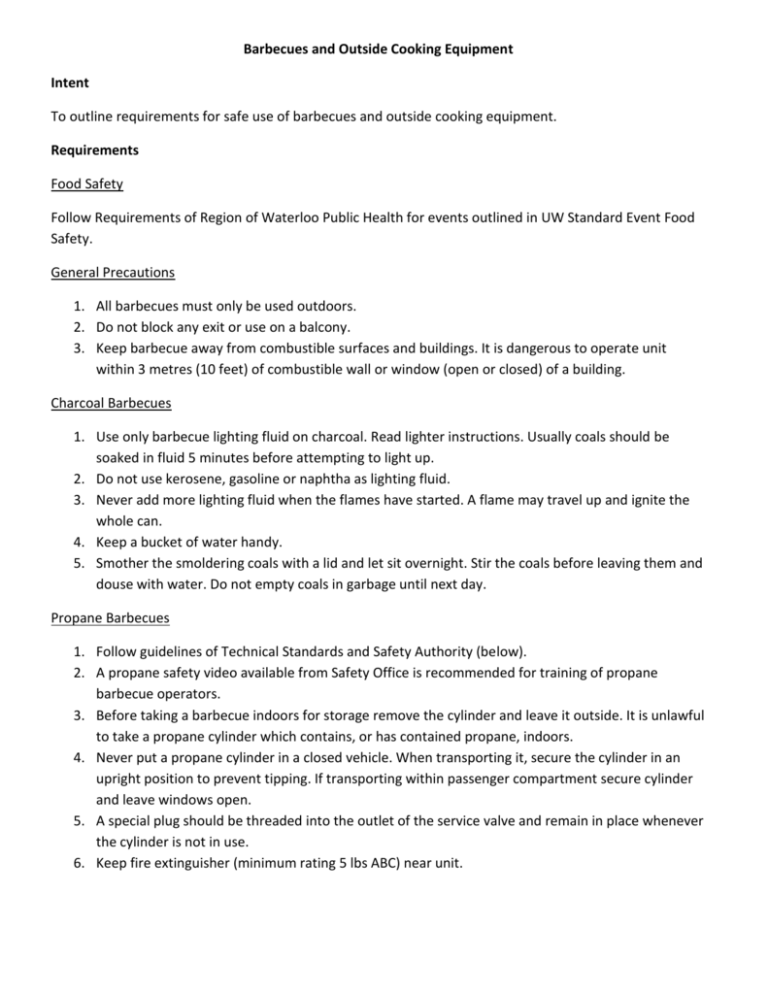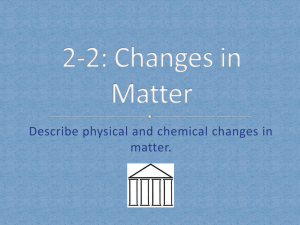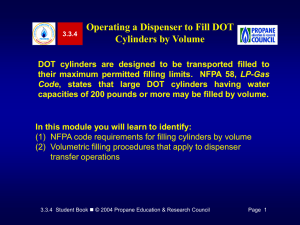BBQ`s & Outside Cooking Equipment
advertisement

Barbecues and Outside Cooking Equipment Intent To outline requirements for safe use of barbecues and outside cooking equipment. Requirements Food Safety Follow Requirements of Region of Waterloo Public Health for events outlined in UW Standard Event Food Safety. General Precautions 1. All barbecues must only be used outdoors. 2. Do not block any exit or use on a balcony. 3. Keep barbecue away from combustible surfaces and buildings. It is dangerous to operate unit within 3 metres (10 feet) of combustible wall or window (open or closed) of a building. Charcoal Barbecues 1. Use only barbecue lighting fluid on charcoal. Read lighter instructions. Usually coals should be soaked in fluid 5 minutes before attempting to light up. 2. Do not use kerosene, gasoline or naphtha as lighting fluid. 3. Never add more lighting fluid when the flames have started. A flame may travel up and ignite the whole can. 4. Keep a bucket of water handy. 5. Smother the smoldering coals with a lid and let sit overnight. Stir the coals before leaving them and douse with water. Do not empty coals in garbage until next day. Propane Barbecues 1. Follow guidelines of Technical Standards and Safety Authority (below). 2. A propane safety video available from Safety Office is recommended for training of propane barbecue operators. 3. Before taking a barbecue indoors for storage remove the cylinder and leave it outside. It is unlawful to take a propane cylinder which contains, or has contained propane, indoors. 4. Never put a propane cylinder in a closed vehicle. When transporting it, secure the cylinder in an upright position to prevent tipping. If transporting within passenger compartment secure cylinder and leave windows open. 5. A special plug should be threaded into the outlet of the service valve and remain in place whenever the cylinder is not in use. 6. Keep fire extinguisher (minimum rating 5 lbs ABC) near unit. Understanding Propane Is Propane Dangerous? Used with care, propane is a safe and convenient fuel. Propane gas is neither toxic nor injurious to you, should you be exposed to it in small quantities. However, should a leak occur, the accumulation of propane gas can become dangerous. Because propane is heavier than air, it tends to settle in the lowest available place. Very small amounts of propane are required to create a flammable mixture of gas and air. In the limited space of a recreation vehicle, for instance, very little propane is needed to create a hazardous situation. How Important Is Ventilation? Propane requires a large volume of air to burn properly. In fact, 23.5 cubic feet of air is needed to burn just one cubic foot of propane. With adequate ventilation, an operating burner gives off a number of harmless products such as carbon dioxide and water vapour however, a propane appliance starved of oxygen can quickly produce dangerous amounts of carbon monoxide. For safety's sake, use your propane appliance only for the purpose for which it was designed. Don't, for example, use a stove as a space heater. How Can Carbon Monoxide Be Detected? Carbon monoxide is both colourless and odourless. It can't be detected by sense of smell. However, the following symptoms may appear: headaches and tightness across the forehead and temples; weariness, weakness, dizziness and nausea; loss of muscular control; watering and smarting of the eyes. If any of these symptoms should develop, get into the fresh air immediately. How Is Propane Stored? For recreational use propane is generally sold and stored in a cylinder. Assuming it is kept in good condition, the cylinder can be refilled indefinitely. When properly filled, a cylinder has about 75 per cent of its volume occupied with liquid propane. The space above the liquid to the top of the cylinder contains propane vapour. An over-filled cylinder is no bargain. Sufficient space must be left in the cylinder to permit expansion of the liquid propane if the cylinder is exposed to warmer temperatures. Without this space, the "relief valve" may open and discharge propane, creating a potential safety hazard. The collars of propane cylinders manufactured in Canada carry markings indicating the cylinders have been manufactured to an acceptable specification. The following information will be found: CTC: Canadian Transport Commission 4B or 4BA: Specifications of the CTC for the design of propane cylinders; 240: Working pressure of the cylinder in pounds per square inch (psi); TW: Tare weight -- Weight of the empty cylinder, with valve; WC: Water capacity -- The amount of water in pounds the cylinder can hold, filling is limited to 42 per cent of the water capacity; Date of manufacture, or, where applicable, re-test date; Manufacturer's name or symbol; Inspector's initials indicating the cylinder was inspected by an inspector certified by the CTC; Serial number Some cylinders may also show the number of pounds of propane. (Cylinders manufactured in the United States show similar information.) A properly filled cylinder should weigh the sum of the tare weight plus 42 per cent of the water weight (WC) capacity of the cylinder. For example, a 20 pound cylinder has a water capacity of 48 pounds. The cylinder's weight after proper filling should be the tare weight plus 42/100 x 48 pounds, or the tare weight plus 20 pounds. The relief valve on a propane cylinder will start to discharge at approximately 375 psi (pounds per square inch) pressure. All propane cylinders are required to be inspected every 10 years starting with the date of manufacture to determine if the cylinder can remain in service and to replace the relief valve. This is law throughout Canada. It is unlawful to fill a cylinder that is overdue for inspection. The Regulator Propane in a cylinder reacts to changes in temperature. When the temperature drops, the pressure in the cylinder drops. When the temperature increases, the pressure increases. The regulator is designed to reduce the variance in pressure in the cylinder and maintain a constant pressure for delivery to an appliance. A regulator should always be installed with its vent opening pointing downwards. If this isn't possible, cover the regulator with a proper cover to prevent the entry of rain or other liquids. The cover will also prevent ice build-up over the vent opening during the winter. A plugged vent opening can cause excessive pressure resulting in high flames when the appliance is ignited. How Should Cylinders Be Handled? The following safety rules apply to the handling of propane cylinders: Never refill a cylinder that is damaged, leaking or corroded. Never put a cylinder in place for use without making sure it is secure. Never put a propane cylinder in a closed vehicle. When transporting it, secure the cylinder in an upright position to prevent tipping. If transporting in the trunk, block the trunk lid open. If transporting within the passenger compartment, leave the windows open. In either case, a special plug should be threaded into the outlet of the service valve and remain in place whenever the cylinder is not in use. This plug, made of metal or plastic, is designed to prevent a leak of propane should the valve be accidentally turned on. Cylinders are painted in light-reflecting colours. If you must repaint them, do not use dark or flat colours which absorb heat. This could cause the propane liquid to expand and be released through the safety valve. Never take a propane cylinder indoors if it contains, or has contained, propane. This is dangerous and unlawful. When purchasing a new cylinder, be sure that it is the size that fits your appliance bracket. Check that all valves on appliances are closed before connecting a new cylinder Watch those connections! When connecting a propane cylinder, use a properly fitting wrench (not pliers) to tighten the connection between the regulator and the cylinder valve (See diagram above). Remember, the fitting that connects to the cylinder valve has to be turned to the left (counter- clockwise) to tighten. Some connectors have a hand wheel requiring only hand tightening. With this type, ensure that the rubber "0" ring is in good condition and in place before connecting to the cylinder valve. The "0" ring is a small rubber-like washer that fits into a groove in front of the threads. Double check this connection when you are doing your "soap and water" leak test (See below). Ensure all connections are tight before operating your propane appliance. Can leaks be detected? Propane is both odourless and colourless when produced. However, in order for you to detect the presence of propane, an odour-producing substance is added to it by the propane producer. This odorant has a distinctive ,'rotten cabbage" smell, which is consumed and not noticeable when a burner is operating. If you detect such an odour, don't light a match or turn an electrical switch on or off. Turn off the cylinder valve, ventilate the area and search out the source of the leak. Your propane system should be checked periodically for leaks even if the characteristic "rotten cabbage" odour is not detected. Check for leaks Before using a propane appliance, particularly if you have just connected a cylinder to it, check for leaks using the following method: 1. 2. 3. 4. 5. 6. 7. 8. 9. Make up a soap and water solution. Turn the cylinder valve on. Spread the soap and water solution over the hose and the connections with a paint brush. Any leaks will result in bubbles forming in the solution. If a leak is indicated, shut off the cylinder valve. Repair any leak by tightening the fitting or replacing the. "0" ring. Repeat (1), (2) and (3) until no leaks are indicated before operating the appliance. If you cannot stop the leaks, consult a qualified service person. Never go over connections looking for leaks with a match, cigarette lighter or any other flame. Propane Barbecues While propane barbecues are cleaner and faster than charcoal, they do present a potential hazard to the careless user. When assembling the unit, follow the manufacturer's instructions carefully. If in doubt, take it back to the dealer or call a qualified service person. A little extra care and these simple precautions should ensure the safe and enjoyable operation of your barbecue: Make sure the burner ports are free of rust or dirt and that the burner orifice is clear of dust or cobwebs. (See manufacturer's instructions.) Check that the hose is in good condition. A damaged or cracked hose can send out a jet of propane which, if ignited, could result in a flame several feet high. Place your barbecue away from combustible surfaces when it is operating. It should not be close to a wooden fence or beneath a combustible roof, overhang or even a low tree. It is unlawful to operate a barbecue within 10 feet of a combustible wall or a window (open or closed) of a building. When lighting your barbecue, have the match or taper already burning and the lid open before you turn on the propane. Never move the barbecue while it is lit. Turn off both the appliance "on-off" valve and the cylinder valve at the conclusion of each use. Check The Labels Before Buying When you purchase a propane barbecue, be sure it carries the symbol of one of the following organizations to ensure the product has been tested and complies with Canadian standards. Canadian Gas Association (CGA); Canadian Standards Association (CSA); Underwriters' Laboratories of Canada (ULC). Use With Care A propane barbecue must only be used outdoors. If you take your barbecue indoors for storage, remove the cylinder and leave it outside. It is unlawful to take a propane cylinder which contains, or has contained, propane indoors.






